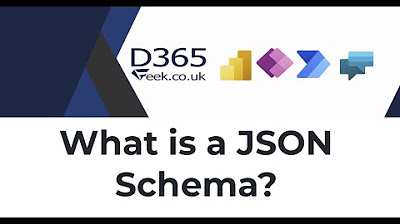Free CCNA | JSON, XML, & YAML | Day 60 | CCNA 200-301 Complete Course
Summary
TLDRIn this informative video, Jeremy introduces data serialization, focusing on JSON as a critical format for exchanging data between applications. He explains JSON's syntax, including its primitive and structured data types, and contrasts it with XML and YAML. The video emphasizes the importance of JSON for CCNA exam preparation and includes a quiz for practice interpreting JSON data, highlighting its human-readability and machine-friendliness.
Takeaways
- 📚 Data serialization is the process of converting data into a standardized format for storage or transmission between applications.
- 🔍 JSON (JavaScript Object Notation) is a widely used data serialization format that is both human-readable and machine-readable, standardized in RFC 8259.
- 📈 JSON supports four primitive data types: string, number, boolean, and null, as well as two structured data types: object and array.
- 🔑 In JSON, strings are surrounded by double quotes, while boolean values (true or false) and null are written without quotes.
- 🎯 Whitespace, including spaces and line breaks, is insignificant in JSON, meaning it does not affect the meaning of the data.
- 🧩 JSON objects are unordered collections of key-value pairs, with keys always being strings and values being any valid JSON data type.
- 🔎 Arrays in JSON are collections of values separated by commas, enclosed in square brackets, and can contain values of different data types.
- 🌐 XML (eXtensible Markup Language) is a data serialization language that uses tags similar to HTML and is less human-readable than JSON but still used by REST APIs.
- 📊 YAML (YAML Ain't Markup Language) is highly human-readable, with significant whitespace and used in tools like Ansible for network automation.
- 📝 The CCNA exam requires understanding of JSON encoded data, with a focus on interpreting basic JSON-formatted data structures.
- 🎯 Practice interpreting JSON data is crucial for the CCNA exam, as it is the primary data serialization format covered in the exam syllabus.
Q & A
What is the primary purpose of data serialization languages?
-The primary purpose of data serialization languages is to provide a standardized format for data so that it can be easily communicated between different applications, even if they are written in different programming languages.
Why is JSON emphasized more than XML and YAML in the CCNA exam?
-JSON is emphasized more in the CCNA exam because the exam specifically mentions the need to be able to interpret JSON encoded data, while XML and YAML are not mentioned in the exam topics list.
What are the four primitive data types in JSON?
-The four primitive data types in JSON are string, number, boolean, and null.
How is whitespace treated in JSON?
-In JSON, whitespace is insignificant, meaning that spaces and line breaks do not change the meaning of the data.
What is the difference between an object and an array in JSON?
-An object in JSON is an unordered list of key-value pairs enclosed in curly brackets, while an array is an ordered list of values separated by commas and enclosed in square brackets.
What does the term 'nested object' refer to in JSON?
-A 'nested object' in JSON refers to an object that is used as the value of a key-value pair within another object.
How is a boolean value represented in JSON?
-A boolean value in JSON is represented as 'true' or 'false', written in all lower-case letters, and without quotes.
What is the significance of the term 'ExSim' in the context of the video?
-ExSim is a software by Boson Software that provides practice exams for the CCNA certification. It is mentioned as a resource for additional practice with a bonus question presented at the end of the video.
How does JSON differ from XML in terms of human readability?
-JSON is generally considered more human-readable than XML due to its simpler syntax and the fact that it uses human-readable keys. XML, while still understandable when formatted properly, is more akin to a markup language and can be less intuitive for quick data extraction.
What is YAML used for in the context of network automation?
-YAML, or YAML Ain't Markup Language, is used in network automation tools such as Ansible for defining configuration and orchestration processes. Its human-readable nature and significance of whitespace make it easy for both humans and machines to understand.
How does the CCNA exam expect candidates to interact with JSON data?
-The CCNA exam expects candidates to be able to interpret JSON encoded data, which involves understanding the structure and being able to extract and interpret information from JSON formatted data.
Outlines

此内容仅限付费用户访问。 请升级后访问。
立即升级Mindmap

此内容仅限付费用户访问。 请升级后访问。
立即升级Keywords

此内容仅限付费用户访问。 请升级后访问。
立即升级Highlights

此内容仅限付费用户访问。 请升级后访问。
立即升级Transcripts

此内容仅限付费用户访问。 请升级后访问。
立即升级浏览更多相关视频

Introduction to Parse JSON in Power Apps | ParseJSON Arrays as Table; Return Array from flow

Pydantic Tutorial • Solving Python's Biggest Problem

What is a JSON Schema? Intro to JSON

Pengolahan Data Dasar Ms. Excel Part 2 - Informatika Kelas 7 SMP/ MTs

Python Tutorial: Working with JSON Data using the json Module

5W+1H: Sistem Informasi Geografi SIG
5.0 / 5 (0 votes)
